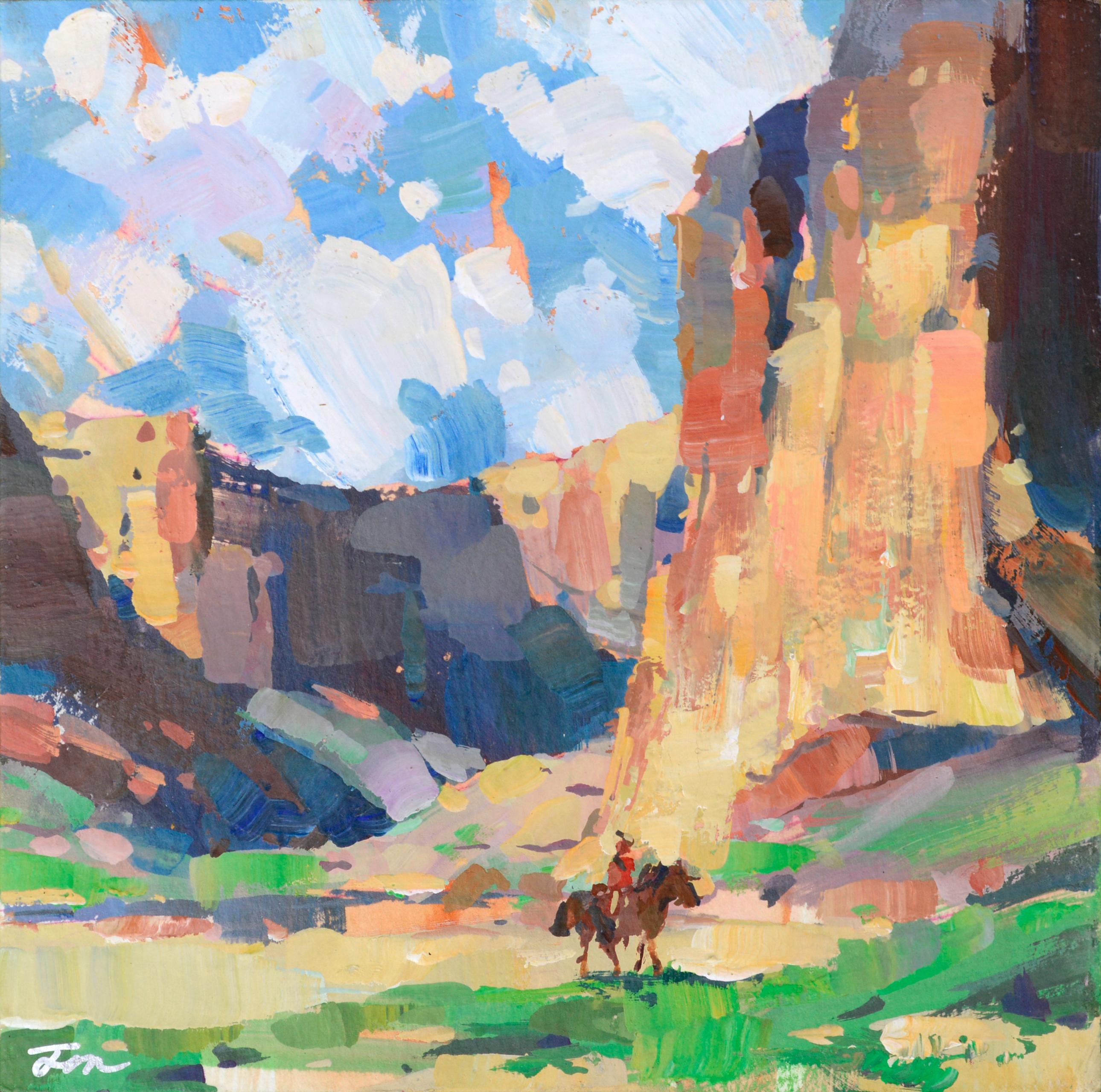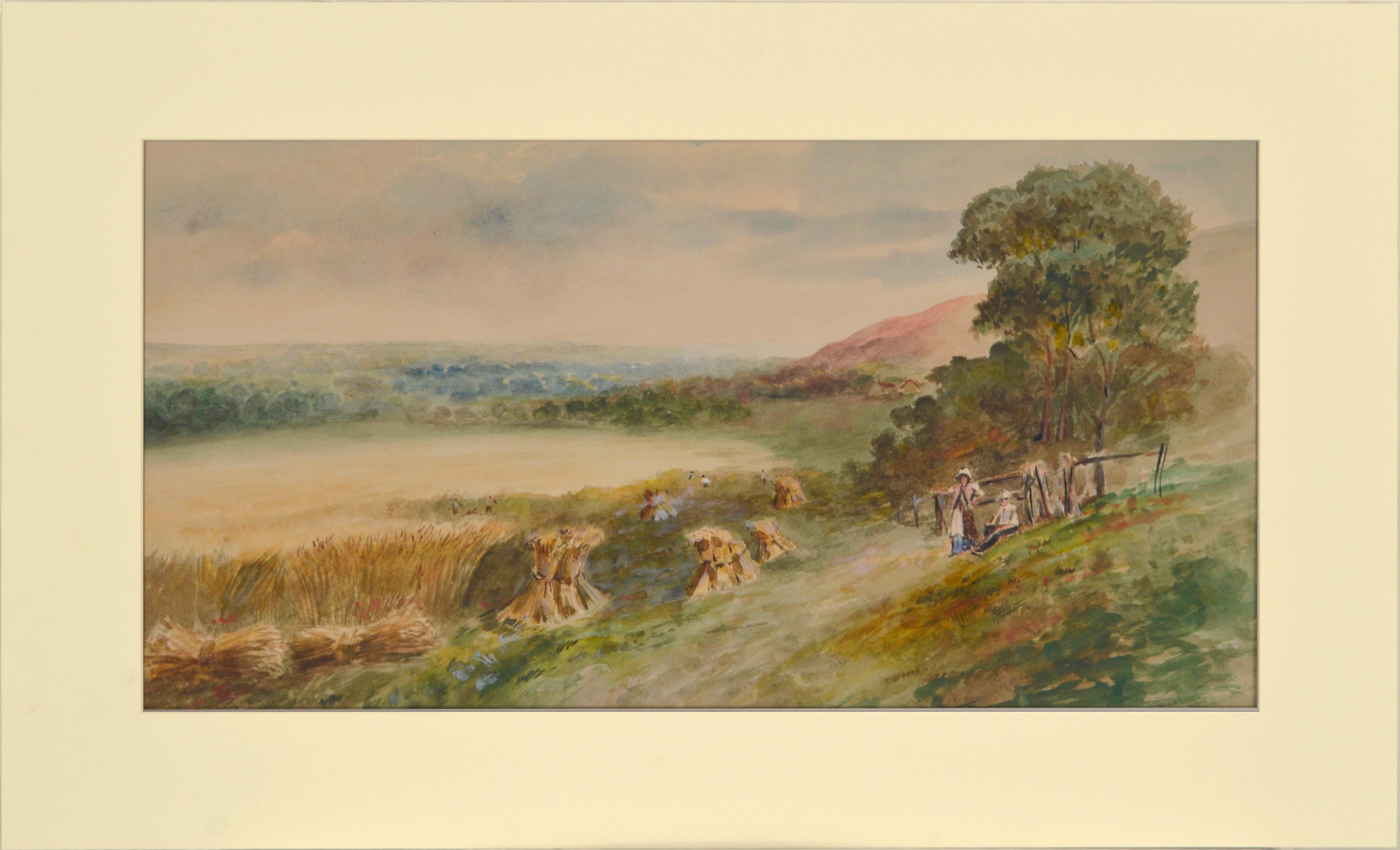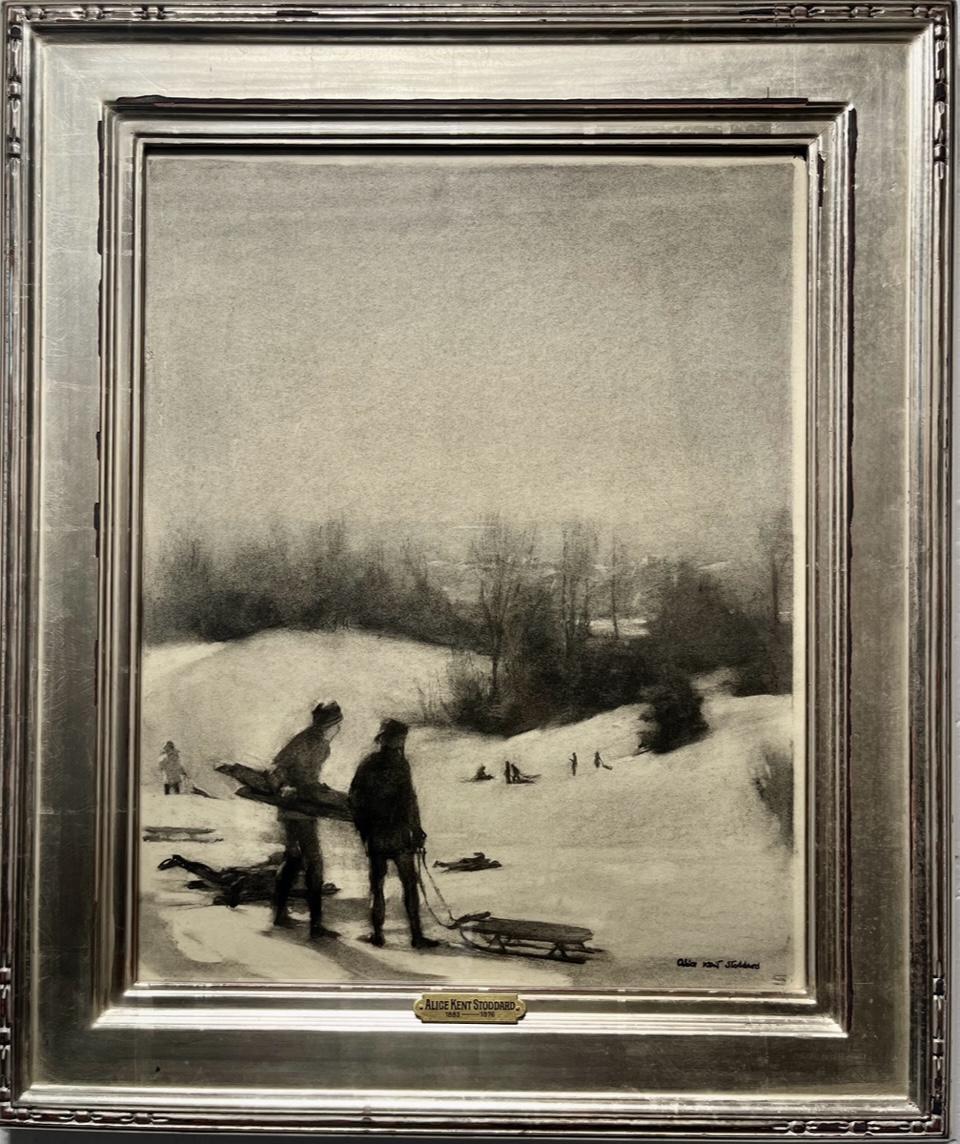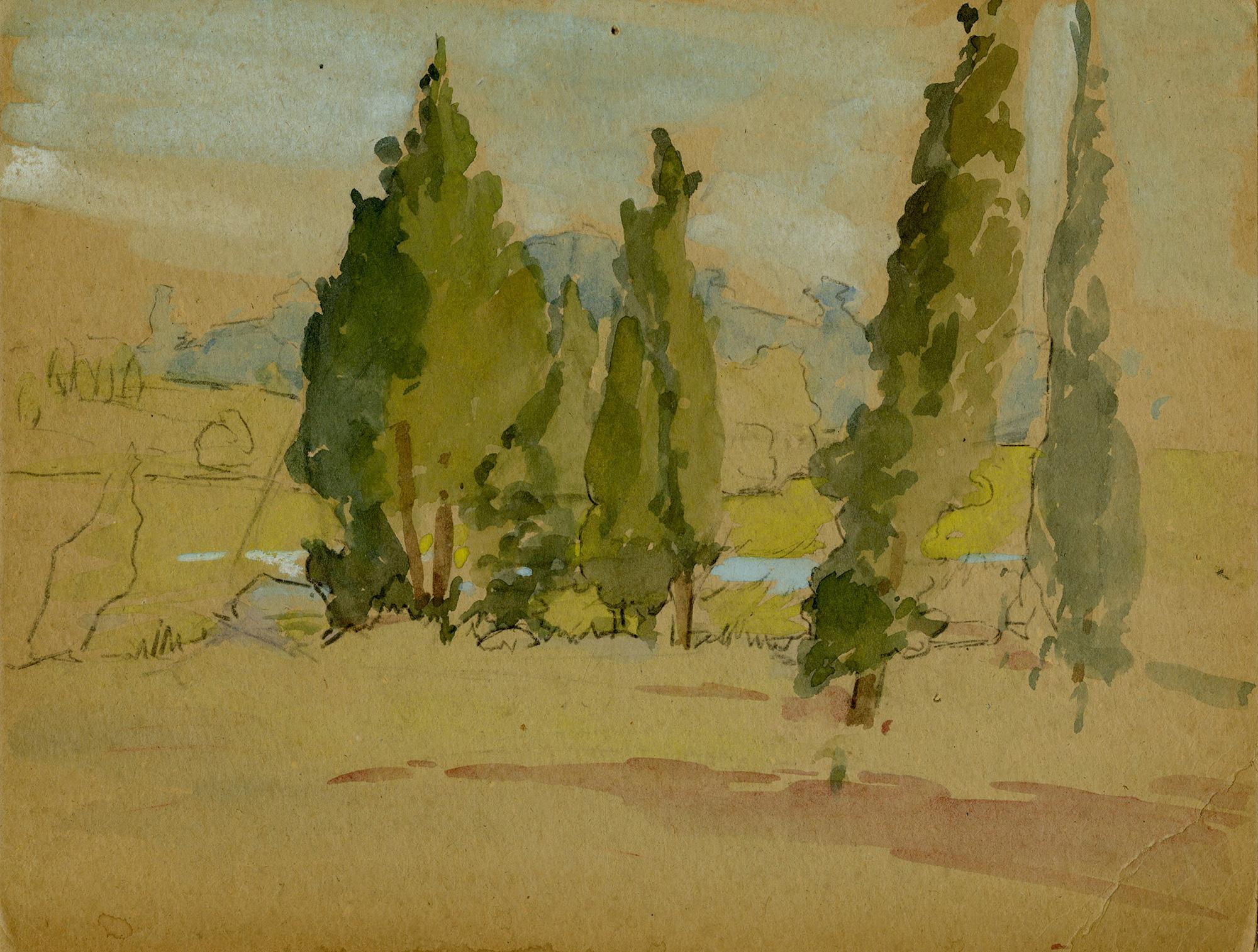Items Similar to Country Lane in the Pine Forest - Mid Century Landscape Watercolor
Want more images or videos?
Request additional images or videos from the seller
1 of 8
Joseph YeagerCountry Lane in the Pine Forest - Mid Century Landscape Watercolorc.1950s-1960s
c.1950s-1960s
About the Item
Wonderful mid century country lane in the pines landscape watercolor by Joseph Yeager (American, 20th Century). This piece is unsigned, but was acquired with a collection of Yeager work directly from the estate. Unframed. Image size: 22"H x 30"W.
Joseph "Joe" Yeager (American, 20th Century) was raised in Cleveland Ohio, where he went to art school at night and started his art career at 19. He was a commercial artist for the Cleveland Press for seven years, and then worked as the paper’s art director for another seven. In the army, he was a technical research illustrator for the National Advisory Committee for Aeronautics. He later moved to Medina, Ohio in 1941 and opened Joe Yeager Industrial Design in 1947. He also taught advanced perspective at the Cleveland School of Art. He studied and painted art in Mexico City in the 1950s. He worked off of engineering drawings provided by numerous manufactures including Ford Motor Company.
- Creator:Joseph Yeager (1892 - 1958, American)
- Creation Year:c.1950s-1960s
- Dimensions:Height: 22 in (55.88 cm)Width: 30 in (76.2 cm)Depth: 0.03 in (0.77 mm)
- Medium:
- Movement & Style:
- Period:
- Condition:Mild tonal ageing to paper, as expected for a piece of this age.
- Gallery Location:Soquel, CA
- Reference Number:
About the Seller
5.0
Platinum Seller
These expertly vetted sellers are 1stDibs' most experienced sellers and are rated highest by our customers.
Established in 1986
1stDibs seller since 2014
2,514 sales on 1stDibs
Typical response time: <1 hour
- ShippingRetrieving quote...Ships From: Soquel, CA
- Return PolicyA return for this item may be initiated within 14 days of delivery.
More From This SellerView All
- Mid Century California Mission LandscapeLocated in Soquel, CABeautiful mid century landscape of a historic California mission, highlighting its iconic architectural details such as a columned arches, white was...Category
Mid-20th Century American Impressionist Landscape Paintings
MaterialsGouache, Cardboard, Paper
- Cowboy in the Canyon, Small Contemporary Multicolor Abstract Figural LandscapeBy Tiffanie MangLocated in Soquel, CASmall-scale yet bold multi-colored abstracted figurative landscape of a horse rider in a canyon (a study after Edgar Payne’s works) by Tiffanie Mang (Ameri...Category
2010s American Impressionist Figurative Drawings and Watercolors
MaterialsGouache, Cardboard
- Harvest Time The Hills of Mt Tamalpais near Lake Bon Tempe 1890sLocated in Soquel, CAHarvest Time The Hills of Mt Tamalpais near Lake Bon Tempe 1890s The Hills around San Rafael in the 19th century were a time of work and play as seen in this watercolor near Lake Bon...Category
Late 19th Century American Impressionist Figurative Drawings and Waterco...
MaterialsWatercolor, Illustration Board, Laid Paper
- The Old Barn - Farmhouse Landscape in Watercolor on PaperLocated in Soquel, CAIdyllic farmhouse landscape by California artist Edwin Haas (American, 1927-2010). A barn with a boarded window is the primary focus of this piece. It is seated in a lush landscape, full of grass, with a small stream running through the center. To the right of the barn is a bare oak tree, and steps can be seen leading to another building. A Sacramento artist...Category
Mid-20th Century American Impressionist Landscape Drawings and Watercolors
MaterialsWatercolor, Laid Paper
- Trees and Rolling Hills Landscape - Gouache on PaperLocated in Soquel, CASmall landscape with large trees by M. J. (Charles) Karnoff (Russian-American). Several large trees occupy the left side of the frame, lining a simple fence. There are some rolling hills in the background, with smaller trees on the horizon. Initialed "M.J.K." in lower right corner. Presented in a new off-white mat...Category
Early 20th Century American Impressionist Landscape Drawings and Waterco...
MaterialsPaper, Gouache
- Methodist Church in Old Bodie Ghost Town - California - Watercolor on PaperLocated in Soquel, CAMethodist Church in Bodie California - Watercolor on Paper Delightful watercolor by California artist Rachel Bentley (American, 1894-1991). The scene d...Category
Mid-20th Century American Impressionist Landscape Drawings and Watercolors
MaterialsPaper, Watercolor
You May Also Like
- Sledders - Winter Snow Scene - Kids playing on Sleds, Charcoal drawing c 1950-60By Alice Kent StoddardLocated in Rancho Santa Fe, CAAlice Kent Stoddard 1885-1976 Sledders (circa 1950-1960) Black chalk on card Image Dimensions: 19.75 x 16 inches (50.2 x 40.6 cm) Framed Dimensions: 26.5 x 22.3 inches Signed lower...Category
Mid-20th Century American Impressionist Figurative Drawings and Watercolors
MaterialsCharcoal, Cardboard
- Pine trees in a river valley with the Blue Ridge Mountains - American SchoolLocated in Middletown, NYAn unfinished but spirited plein-air composition of what appears to be the Shenandoah or Potomac River valley with the Blue Ridge Mountains in the distance. Watercolor on board with...Category
Early 1900s American Impressionist Landscape Drawings and Watercolors
MaterialsCrayon, Watercolor, Board
- "House on a Hill, " Clara Bell, Female Artist Landscape, American ImpressionismLocated in New York, NYClara Louise Bell (1886 - 1978) House on a Hill, circa 1935 Gouache on artist board 7 1/4 x 9 7/8 inches Clara Louise Bell (Mrs.Bela Janowsky) was b...Category
1930s American Impressionist Landscape Paintings
MaterialsGouache, Board
- The Rapids (Maine)By John WhorfLocated in Provincetown, MAJohn Whorf, born in 1903, was a talented, opinionated artist who achieved great success at a young age. Encouraged by his artistic father, Whorf studied briefly during his early te...Category
Early 20th Century American Impressionist Landscape Drawings and Waterco...
MaterialsPaper, Watercolor
- "Untitled 1, " Watercolor PaintingLocated in Denver, COClyde Steadman's "Untitled 1" is an original, handmade watercolor painting that depicts an urban landscape with human silhouettes.Category
2010s American Impressionist Figurative Drawings and Watercolors
MaterialsPaper, Watercolor
- "Train Station, " Max Kuehne, Industrial City Scene, American ImpressionismBy Max KuehneLocated in New York, NYMax Kuehne (1880 - 1968) Train Station, circa 1910 Watercolor on paper 8 1/4 x 10 1/4 inches Signed lower right Provenance: Private Collection, Illinois Max Kuehne was born in Halle, Germany on November 7, 1880. During his adolescence the family immigrated to America and settled in Flushing, New York. As a young man, Max was active in rowing events, bicycle racing, swimming and sailing. After experimenting with various occupations, Kuehne decided to study art, which led him to William Merritt Chase's famous school in New York; he was trained by Chase himself, then by Kenneth Hayes Miller. Chase was at the peak of his career, and his portraits were especially in demand. Kuehne would have profited from Chase's invaluable lessons in technique, as well as his inspirational personality. Miller, only four years older than Kuehne, was another of the many artists to benefit from Chase's teachings. Even though Miller still would have been under the spell of Chase upon Kuehne's arrival, he was already experimenting with an aestheticism that went beyond Chase's realism and virtuosity of the brush. Later Miller developed a style dependent upon volumetric figures that recall Italian Renaissance prototypes. Kuehne moved from Miller to Robert Henri in 1909. Rockwell Kent, who also studied under Chase, Miller, and Henri, expressed what he felt were their respective contributions: "As Chase had taught us to use our eyes, and Henri to enlist our hearts, Miller called on us to use our heads." (Rockwell Kent, It's Me O Lord: The Autobiography of Rockwell Kent. New York: Dodd, Mead and Co., 1955, p. 83). Henri prompted Kuehne to search out the unvarnished realities of urban living; a notable portion of Henri's stylistic formula was incorporated into his work. Having received such a thorough foundation in art, Kuehne spent a year in Europe's major art museums to study techniques of the old masters. His son Richard named Ernest Lawson as one of Max Kuehne's European traveling companions. In 1911 Kuehne moved to New York where he maintained a studio and painted everyday scenes around him, using the rather Manet-like, dark palette of Henri. A trip to Gloucester during the following summer engendered a brighter palette. In the words of Gallatin (1924, p. 60), during that summer Kuehne "executed some of his most successful pictures, paintings full of sunlight . . . revealing the fact that he was becoming a colorist of considerable distinction." Kuehne was away in England the year of the Armory Show (1913), where he worked on powerful, painterly seascapes on the rocky shores of Cornwall. Possibly inspired by Henri - who had discovered Madrid in 1900 then took classes there in 1906, 1908 and 1912 - Kuehne visited Spain in 1914; in all, he would spend three years there, maintaining a studio in Granada. He developed his own impressionism and a greater simplicity while in Spain, under the influence of the brilliant Mediterranean light. George Bellows convinced Kuehne to spend the summer of 1919 in Rockport, Maine (near Camden). The influence of Bellows was more than casual; he would have intensified Kuehne's commitment to paint life "in the raw" around him. After another brief trip to Spain in 1920, Kuehne went to the other Rockport (Cape Ann, Massachusetts) where he was accepted as a member of the vigorous art colony, spearheaded by Aldro T. Hibbard. Rockport's picturesque ambiance fulfilled the needs of an artist-sailor: as a writer in the Gloucester Daily Times explained, "Max Kuehne came to Rockport to paint, but he stayed to sail." The 1920s was a boom decade for Cape Ann, as it was for the rest of the nation. Kuehne's studio in Rockport was formerly occupied by Jonas Lie. Kuehne spent the summer of 1923 in Paris, where in July, André Breton started a brawl as the curtain went up on a play by his rival Tristan Tzara; the event signified the demise of the Dada movement. Kuehne could not relate to this avant-garde art but was apparently influenced by more traditional painters — the Fauves, Nabis, and painters such as Bonnard. Gallatin perceived a looser handling and more brilliant color in the pictures Kuehne brought back to the States in the fall. In 1926, Kuehne won the First Honorable Mention at the Carnegie Institute, and he re-exhibited there, for example, in 1937 (Before the Wind). Besides painting, Kuehne did sculpture, decorative screens, and furniture work with carved and gilded molding. In addition, he designed and carved his own frames, and John Taylor Adams encouraged Kuehne to execute etchings. Through his talents in all these media he was able to survive the Depression, and during the 1940s and 1950s these activities almost eclipsed his easel painting. In later years, Kuehne's landscapes and still-lifes show the influence of Cézanne and Bonnard, and his style changed radically. Max Kuehne died in 1968. He exhibited his work at the National Academy of Design, the Art Institute of Chicago, the Carnegie Institute in Pittsburgh, the Memorial Art Gallery of the University of Rochester, and in various New York City galleries. Kuehne's works are in the following public collections: the Detroit Institute of Arts (Marine Headland), the Whitney Museum (Diamond Hill...Category
1910s American Impressionist Landscape Drawings and Watercolors
MaterialsPaper, Watercolor
Recently Viewed
View AllMore Ways To Browse
The Pines
Mid Century Landscape
Another Country
1950s Country
Joseph C
Cleveland School
Cleveland School Of Art
Mid Century Drawing Mexico
American Motors
American School Forest
Engineering Drawings
Night Forest
Joseph Press
Joseph Presser
Night Forest Painting
Country Lane Painting
Ford Motor
Vintage Engineering Drawings





